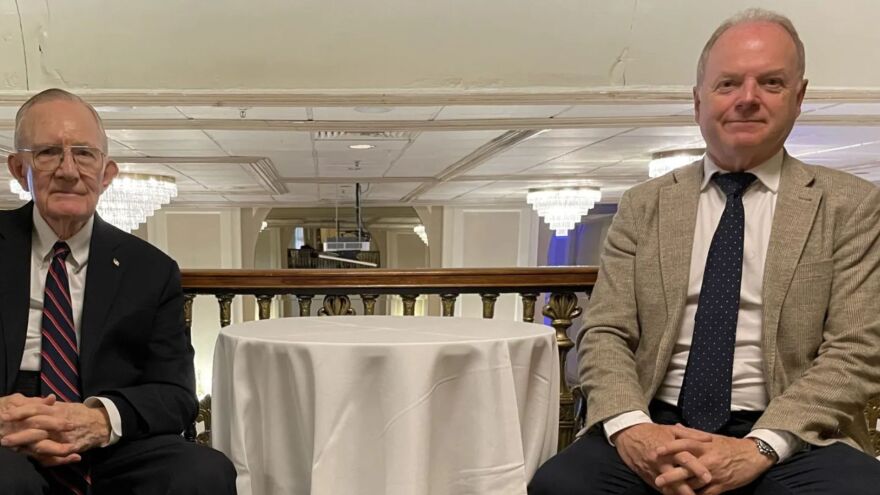BETHLEHEM, Pa. — Hoping to have Historic Moravian Bethlehem join the cultural ranks of Independence Hall, Yellowstone National Park and the Statue of Liberty, city history officials this week met with a consultant about its potential as a future World Heritage Site.
Barry Gamble is an independent consultant assigned as World Heritage adviser to evaluate the transnational nomination of three Moravian Church settlements: Historic Moravian Bethlehem; Herrnhut, Saxony, Germany; and Gracehill, Northern Ireland, United Kingdom.
- Historic Moravian Bethlehem is in the running for World Heritage status
- If selected alongside two other sites in Germany and the UK, it would join an already selected site in Denmark as part of an “expansion”
- A final decision could be made by the middle of 2024
Working closely with the three involved countries and the United Nations Educational, Scientific and Cultural Organization, Gamble will provide coordination at the state and site level.
“My role is to coordinate and deliver the nomination dossier to UNESCO, which we’ve now done,” Gamble said. “That’s an extensive file: the nomination document itself [is] 350 pages, an international management plan and various annexes.”
Gamble said the three nominations will represent an “extension,” potentially going on to join an existing World Heritage site in Denmark — Christiansfeld, a Moravian Church Settlement.
“[The World Heritage Committee] called it a phenomenon that was not adequately represented by one site — and Bethlehem is the preeminent site in North America.”Barry Gamble, independent consultant
The World Heritage Committee "called it a phenomenon that was not adequately represented by one site — and Bethlehem is the pre-eminent site in North America,” Gamble explained.
“Herrnhut is the mother settlement, the origin of the renewed Moravian Church in Saxony, and Gracehill was an exemplar of a planned settlement in the wilds of the North of Ireland at the time.”
‘Outstanding universal value’
Gamble said the World Heritage Convention aims to promote peace, protection and the passing of the universal heritage of humankind. As a result, choosing the sites in question involves a highly selective process.
“This place is special because the United States government recognized how significant Bethlehem is, and put Bethlehem on its tentative list to consider a nomination for World Heritage,” Gamble said.
“The fact that it’s now been nominated shows the confidence of the government, shows the confidence of the collective governments, that this is a heritage of what’s termed ‘outstanding universal value’ — significant, so exceptional, that it transcends national boundaries to be of significance for all humanity.”
Curtis H. "Hank" Barnette, vice chairman of the Bethlehem World Heritage Commission as well as a longtime resident of the city, said the people involved in the process fully intend to see it through to the end.
“The commission and council are made up of our exceptional community leaders, and [we] are uniform in our support for the objective of achieving World Heritage status."Hank Barnette, vice chair of the Bethlehem World Heritage Commission
“The commission and council are made up of our exceptional community leaders, and [we] are uniform in our support for the objective of achieving World Heritage status,” Barnette said. “We have just excellent advice.”
Gamble and Barnette agreed that if you compared Bethlehem’s Moravian Church settlement to those across the pond, the design's authenticity speaks for itself.
“The basis of the designs [here] were made by the Moravian Church in Saxony, the building commission,” Gamble said. “They’re adapted to local materials and local needs — but you swear you’re in the same place.”
A six-step process
Barnette said the Bethlehem settlement is in its third of six steps that in the selection process,
Barnette detailed the process:
- A site is placed on a tentative World Heritage list by the state party, which in this case is the United States;
- The U.S. government must nominate the site;
- Once the site is nominated, a qualified entity must come and evaluate. The World Heritage Committee evaluates, with assistance from the World Heritage Convention and the International Council on Monuments and Sites;
- The site must be elected by an international committee that meets and considers the recommendations;
- If selected, the site then is inscribed;
- Finally, the site is considered operational.
“The four Moravian Church settlements — four different countries, four different cities — will all be part of a single Moravian Church settlement site; that’s the plan,” Barnette said.
Gamble "is the leader in making that happen,” he said.
What lies ahead
During the annual meeting of the UNESCO World Heritage Committee — comprising 21 nation states — in Paris, there will be a recommendation made by the secretariat of UNESCO of the World Heritage Center.
A recommendation from the International Council on Monuments and Sites then will go forward to the committee as a draft decision, there will be a presentation of the report and then the committee will consider the proposal further.
“It’s the committee, and the committee alone, that have that role to say whether a site is inscribed or not,” Gamble said.
The public should know more on the official decision by the middle of 2024, Gamble said.
The U.S. Department of the Interior first submitted the application for Bethlehem's historic Moravian Church settlement to be designated a World Heritage Site in February.


